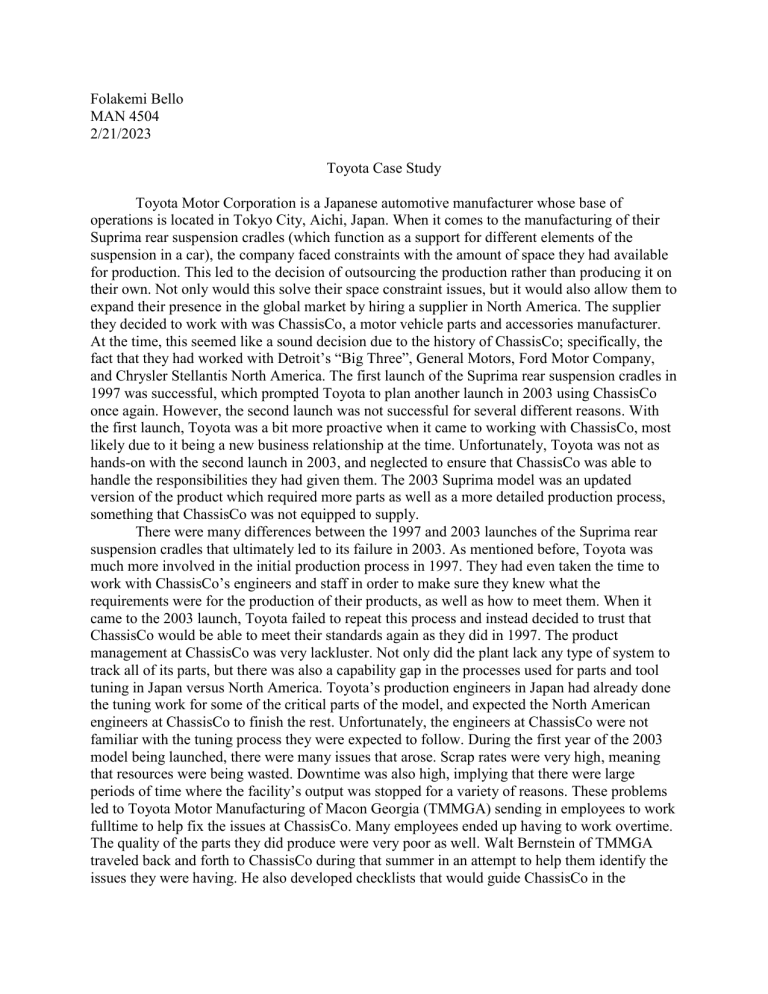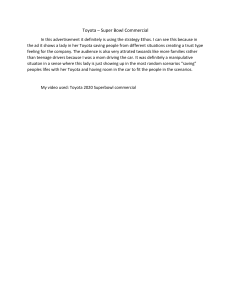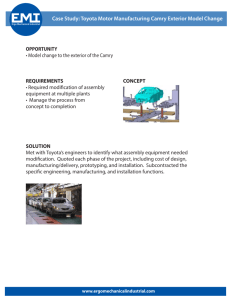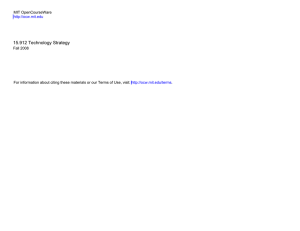
Folakemi Bello MAN 4504 2/21/2023 Toyota Case Study Toyota Motor Corporation is a Japanese automotive manufacturer whose base of operations is located in Tokyo City, Aichi, Japan. When it comes to the manufacturing of their Suprima rear suspension cradles (which function as a support for different elements of the suspension in a car), the company faced constraints with the amount of space they had available for production. This led to the decision of outsourcing the production rather than producing it on their own. Not only would this solve their space constraint issues, but it would also allow them to expand their presence in the global market by hiring a supplier in North America. The supplier they decided to work with was ChassisCo, a motor vehicle parts and accessories manufacturer. At the time, this seemed like a sound decision due to the history of ChassisCo; specifically, the fact that they had worked with Detroit’s “Big Three”, General Motors, Ford Motor Company, and Chrysler Stellantis North America. The first launch of the Suprima rear suspension cradles in 1997 was successful, which prompted Toyota to plan another launch in 2003 using ChassisCo once again. However, the second launch was not successful for several different reasons. With the first launch, Toyota was a bit more proactive when it came to working with ChassisCo, most likely due to it being a new business relationship at the time. Unfortunately, Toyota was not as hands-on with the second launch in 2003, and neglected to ensure that ChassisCo was able to handle the responsibilities they had given them. The 2003 Suprima model was an updated version of the product which required more parts as well as a more detailed production process, something that ChassisCo was not equipped to supply. There were many differences between the 1997 and 2003 launches of the Suprima rear suspension cradles that ultimately led to its failure in 2003. As mentioned before, Toyota was much more involved in the initial production process in 1997. They had even taken the time to work with ChassisCo’s engineers and staff in order to make sure they knew what the requirements were for the production of their products, as well as how to meet them. When it came to the 2003 launch, Toyota failed to repeat this process and instead decided to trust that ChassisCo would be able to meet their standards again as they did in 1997. The product management at ChassisCo was very lackluster. Not only did the plant lack any type of system to track all of its parts, but there was also a capability gap in the processes used for parts and tool tuning in Japan versus North America. Toyota’s production engineers in Japan had already done the tuning work for some of the critical parts of the model, and expected the North American engineers at ChassisCo to finish the rest. Unfortunately, the engineers at ChassisCo were not familiar with the tuning process they were expected to follow. During the first year of the 2003 model being launched, there were many issues that arose. Scrap rates were very high, meaning that resources were being wasted. Downtime was also high, implying that there were large periods of time where the facility’s output was stopped for a variety of reasons. These problems led to Toyota Motor Manufacturing of Macon Georgia (TMMGA) sending in employees to work fulltime to help fix the issues at ChassisCo. Many employees ended up having to work overtime. The quality of the parts they did produce were very poor as well. Walt Bernstein of TMMGA traveled back and forth to ChassisCo during that summer in an attempt to help them identify the issues they were having. He also developed checklists that would guide ChassisCo in the activities they needed to work on. Ultimately, ChassisCo lacked the quality certification and inventory management that was required of them to successfully produce the 2003 Suprima model on their own. At the ChassisCo Athens plant, there was a huge crisis in late 2004. Since ChassisCo’s global development organization was decentralized in 2000, employees had been split up in order to work for three different independent geographic groups. This meant that their capabilities had weakened from 1997 to 2003 since efforts had been broken up into smaller factions. ChassisCo also had built up a larger clientele globally without supplementing their employee roster. Their employees in maintenance, materials, tool and die, and supplier management were spread thin across many different projects, leading to there not being enough effort allocated to the Suprima production. For example, the Athens base only supplied 2 out of the 12 necessary tool and die engineers for the project. There was also a lack of any type of systems at the Athens plant that would ensure the inspection of these products as well as deal with any malfunctions that occurred. The responsibilities that Toyota placed on the Athens plant were as follows: ensure that parts sourcing, incoming logistics and inventory management was being correctly handled, and to be capable of following the engineering processes of Toyota’s Japanese engineers. This would require the Athens plant to have good project management skills, as well as the proper systems in place to ensure that parts are being tracked and malfunctions are being addressed correctly. Toyota’s responsibilities included: supporting their suppliers by following one of Toyota’s core practices, TPS (meaning “go to the source and see things yourself”), analyzing the cost of their production to ensure that their suppliers were capable of reaching target prices, providing adequate resources (including staff) in order to fill capability gaps, and ensure that significant inspections were being implemented to identify and repair any defects before the product’s official launch. Both companies failed to deliver on their required commitments to the operation, and there were many ways that these issues could have been avoided. On both Toyota and ChassisCo’s parts, there were multiple different things that could have been implemented to resolve the crisis that occurred and ensure that something like this never happens again. For inventory management, ChassisCo needs to establish a system that would monitor and keep track of all inventories. From this point, Toyota would need to oversee this process and even perform regular audits to make sure that the system was adequate. ChassisCo also needs to ensure that employees are being utilized in a way that prioritizes their bigger projects. This would mean that they would need to not only allocate more employees for these projects, but to also make sure that they were adequately trained for the jobs they needed to do. To help with this issue, Toyota needs to provide the correct training for the process in which their parts are produced, as they did with the 1997 Suprima. Both companies need to do a better job of communicating with one another in regard to any issues that arise during production in order to quickly handle them before the issue escalates into another crisis. If I were in charge at ChassisCo, I would have started by communicating our complications to Toyota. Ultimately, ChassisCo was not equipped to handle the production of the 2003 Suprima rear suspension cradle, and at the very least the launch should have been delayed in order to ensure that there was enough time to address any issues. One of the big issues was that the ChassisCo engineers were not able to implement the necessary production methods done by the Toyota engineers in Japan. As the person in charge, I would have requested that Toyota provide the necessary training to fill any knowledge gaps our engineers had, ensuring that the production of these parts was up to par. Another thing I would have done was to allocate more resources and employees to the Athens plant after the success of the St. Louis plant in their production of rear suspension cradles for the Toyota Responsa launch in 1999. This would include hiring more project managers as well. This would help the efficiency of the production and guarantee that there were enough people in place to stay in communication with Toyota and implement systems that track our inventory & malfunctions. If I were in charge at Toyota, I would have also started by delaying the 2003 Suprima launch. Since they were already aware of certain issues that were happening at the Athens plant, it would have been a much better idea to delay the launch in order to avoid a negative impact on Toyota’s reputation, as well as to avoid compromising the quality of any parts used in their cars. I would have also made sure that regular audits and inspections were being done at ChassisCo to catch any issues and deal with them before they became too big of a problem. This would have prompted me to take some of the responsibility off ChassisCo and temporarily transfer production back to other suppliers upon discovery of the capacity issues at the Athens plant. I would have made sure to provide the correct training and supervising necessary to ensure that the Athens engineers and crew were capable of performing the duties we asked of them before bestowing the responsibility of production on them once again. Overall, both companies failed to do what was necessary to avoid these issues. ChassisCo took on more than they could handle, and since they never established a system to correct any issues that arose, they produced lackluster parts as a result. Toyota was not as proactive as they should have been when it comes to the production of necessary components. Rather than communicating with and supplementing their partners when necessary, they put too much trust in ChassisCo and their ability to meet their standards. Being more hands-on would have given Toyota the chance to halt the production of faulty parts and protect the reputation of their company. In conclusion, following these suggestions would ensure that both companies avoided any future crises like this with one another as well as in future partnerships.






